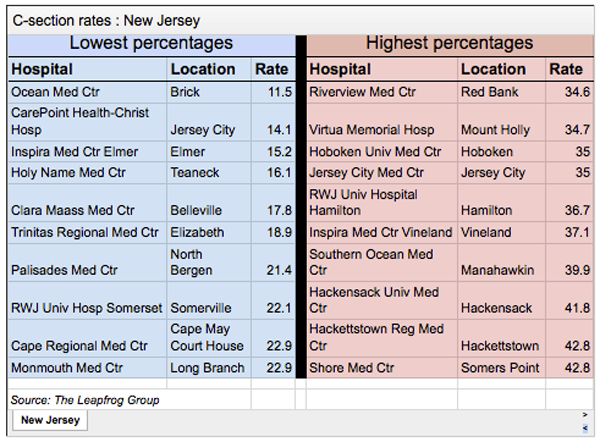Effort to reduce NJ’s high C-Section rate could be aided by new report
Listen
(Photo via ShutterStock)
When doctors or hospitals recommend cesarean sections because they’re convenient and easy to schedule, they may be acting more in their own interests than in the interests of their patients. But for women who want a physician who’s interested first and foremost in their health and their unborn child’s health, a new report should make it far easier for them to find the providers who do just that.
This is a particularly important issue in New Jersey, which has historically been among the states with the highest rates of C-sections, although that has moderated slightly in recent years.
The report from the Washington, D.C.-based Leapfrog Group, shows that C-section deliveries for first-time mothers are performed at widely different rates in New Jersey hospitals. They range from a low of 11.5 percent at Ocean Medical Center in Brick to 42.8 percent at Hackettstown Regional Medical Center and Shore Medical Center in Somers Point.
New Jersey’s statewide C-section average of 28.1 percent in 2014 put it 23rd of 33 states that had at least six hospitals report data. The Leapfrog Group research represents the first national report that includes hospital-level C-section data that can be compared across state lines. The group hopes that the report helps inspire a nationwide effort similar to one that led hospitals to dramatically cut the rate of early induced-labor deliveries over the past five years.
 Of 47 New Jersey hospitals that reported data, 13 had C-section rates below the national standard of 23.9 percent set by the federally backed effort Healthy People 2020, which in 2010 set science-based, 10-year national objectives for a variety of health measures. Of New Jersey hospitals, 27.7 percent met this standard, which is below the nationwide share of 39.1 percent of hospitals.
Of 47 New Jersey hospitals that reported data, 13 had C-section rates below the national standard of 23.9 percent set by the federally backed effort Healthy People 2020, which in 2010 set science-based, 10-year national objectives for a variety of health measures. Of New Jersey hospitals, 27.7 percent met this standard, which is below the nationwide share of 39.1 percent of hospitals.
“It shouldn’t be surprising — but it is — that the vast majority of hospitals don’t meet the standard,” said Leah Binder, president and CEO for the Leapfrog Group, a nonprofit that aims to mobilize employers’ purchasing power to improve healthcare safety, quality, and value. That’s because, while C-sections became common practice for many doctors and hospitals, awareness of potential complications from the procedures is also widespread.
Some Cesarean sections — in which a baby is delivered through an incision in the mother’s abdomen — are medically necessary, such as when a baby is positioned sideways. But while the World Health Organization estimates the share that are necessary at 10 percent to 15 percent, the percentage of American C-sections rose from 5.5 percent in 1970 to 32.9 percent in 2009. One factor driving the increase was convenience.
In New Jersey, the statewide C-section share rose from 25 percent of first-time mothers in 2000 to 36 percent in 2009, then fell to 33 percent in 2013, according to state statistics. These findings aren’t directly comparable to the Leapfrog Group’s because they’re adjusted using different methods.
Binder said the variation between New Jersey hospitals “suggests that there’s really not enough attention being paid by hospitals to bringing down these rates in a strategic way. It can be done.”
New Jersey Health Care Quality Institute President and CEO Linda Schwimmer, a Leapfrog Group board member, said a variety of factors can change a region’s culture to drive down the C-section rates. They include leadership from hospital executives and doctors, consumer education, and conversations between expectant mothers and their obstetricians and nurse-midwives.
Once these factors converge, “you’re going to see that (C-section rate) going down,” Schwimmer said. “And that’s going to be very important progress for moms and babies.”
She sees this first report as a “benchmark,” putting a spotlight on the issue.
Binder said hospitals leaders have to make lowering the number of C-sections a priority, set goals, and measure their progress in order to lower the rates. Advocates also urge mothers to ask their doctors about the potential benefits of vaginal births, which include shorter and less-painful recovery, as well as a lower risk of infection and surgery-related injuries.
Binder said she hopes that the report becomes a tool for women who are weighing where they want their baby to be delivered. And with more than half of deliveries paid for through Medicaid, she said that all taxpayers have a stake in ensuring that deliveries are a safe as possible.
While some New Jersey hospitals trail the pack in their C-section rates, Binder said she was most concerned about the 10 hospitals in the state that declined to respond to the Leapfrog survey.
“You do have to worry as to why they’re not reporting,” she said.
Binder anticipates that the Leapfrog Group will continually raise the bar for improving C-section rates. It took that approach with early elective deliveries, beginning with a goal of 12 percent in 2010 before lowering it to 5 percent this year after many hospitals began to exceed the goals.
“We’re trying to really push hospitals and health systems to continually set a higher bar,” she said.
WHYY is your source for fact-based, in-depth journalism and information. As a nonprofit organization, we rely on financial support from readers like you. Please give today.




